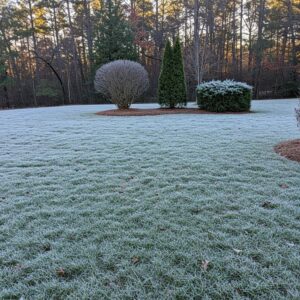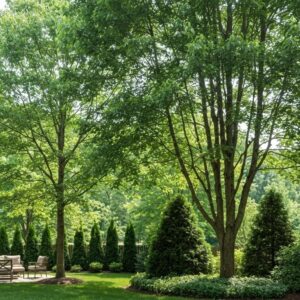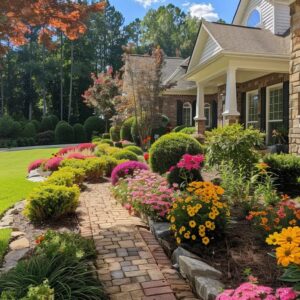Georgia homeowners face a challenge: creating beautiful, sustainable landscaping in Georgia that doesn’t require constant upkeep. This guide explores the best low-maintenance plants for eco-friendly yards in Georgia. We’ll cover how to select native plants that thrive in local conditions, design principles for sustainablelandscapes, and practical maintenance tips. By the end, you’ll have the knowledge to transform your yard into a vibrant, eco-friendly oasis that saves time, water, and energy while supporting local wildlife.
Sustainable Landscaping in Georgia: Thrive in Any Season
Understanding Sustainable Landscaping in Georgia
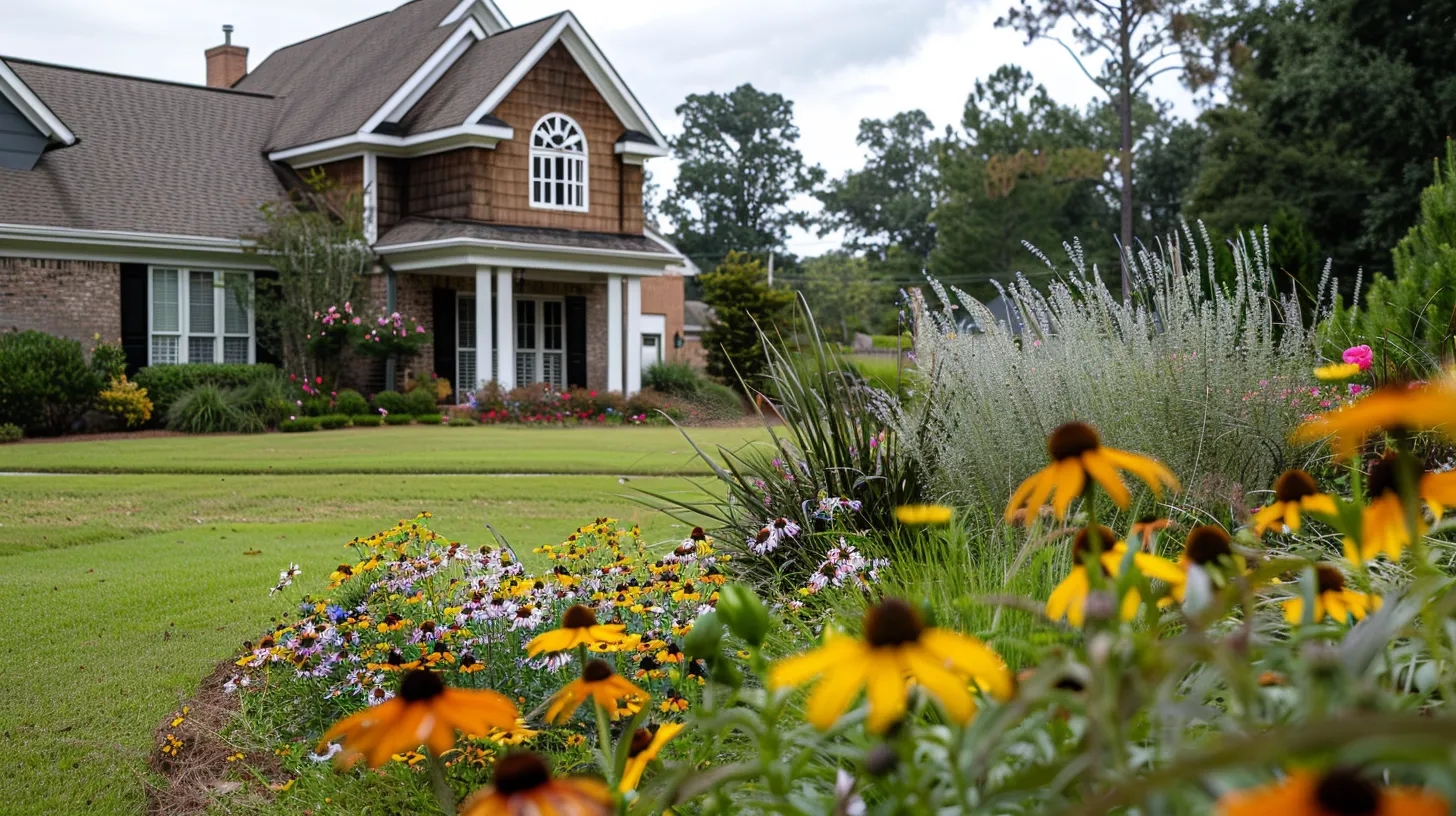
Sustainable landscaping in Georgia centers on eco-friendly practices tailored to the state’s climate and soil types. This approach benefits both the environment and homeowners, incorporating native species and organic methods. From selecting drought-resistant flowers to using permeable pavers, sustainable techniques create low-maintenance, beautiful landscapes that thrive in Georgia’s unique conditions.
Defining Sustainable Landscaping
Sustainable landscaping in Georgia focuses on creating outdoor spaces that minimize waste and conserve resources while enhancing soilhealth and aesthetics. This approach emphasizes the use of native plants, efficient irrigation systems, and organic practices to reduce waterconsumption and chemical inputs.
Education plays a crucial role in sustainable landscaping, as homeowners learn to work with Georgia‘s unique climate and ecosystems. By adopting these practices, residents can create beautiful, low-maintenance yards that support local biodiversity and reduce their environmental impact.
Benefits of Sustainable Practices
Sustainable landscaping practices offer numerous benefits for Georgia homeowners and the environment. These projects conserve natural resources by reducing water consumption and minimizing chemical inputs. Efficient irrigation systems and proper soil moisture management techniques help maintain lush landscapes while using less water, even during dry periods.
Implementing sustainable landscaping services can lead to long-term cost savings and increased property value. Features like retaining walls made from local materials not only add aesthetic appeal but also prevent soil erosion and improve drainage. The following sustainable practices benefit both homeowners and the environment:
- Water conservation through efficient irrigation
- Soilhealth improvement using organic methods
- Reduced maintenance needs with native plants
- Enhanced biodiversity and wildlifehabitat
- Improved air and water quality
Climate Considerations in Georgia
Georgia‘s climate presents unique challenges and opportunities for sustainable landscaping. The state’s hot summers and mild winters require thoughtful plant selection to ensure sustainability and beauty throughout the year. Native species adapted to local conditions thrive with minimal intervention, promoting biodiversity and reducing the need for excessive watering or chemical inputs.
Sustainable landscaping practices in Georgia focus on conserving water and enhancing soilhealth. By implementing rainwater harvesting systems and using drought-resistant plants, homeowners can create beautiful landscapes that withstand periods of low rainfall. Additionally, incorporating organicmatter into the soil improves nutrient retention and supports healthy plant growth, benefiting both ornamental gardens and small-scale agriculture:
Soil Types and Their Importance
Georgia‘s diverse soil types play a crucial role in sustainable landscaping practices. From the red clay of the Piedmont region to the sandy soils of the coastal plains, each type presents unique challenges and opportunities for planthealth and habitat creation. Understanding these soil characteristics helps homeowners select appropriate plants and implement effective management techniques.
Proper soil management enhances plant resilience against disease and supports a thriving ecosystem. By improving soil structure and nutrient content, landscapers create ideal conditions for native plants, which in turn attract pollinators and birds. This approach fosters a sustainable landscape that benefits both the environment and the homeowner:
- Red clay soil: Requires organicmatter for improved drainage
- Sandy soil: Benefits from compost to increase water retention
- Loamy soil: Ideal for most plants, needs minimal amendment
- Silty soil: Compacts easily, requires careful management
Selecting Low-Maintenance Plants for Georgia Gardens
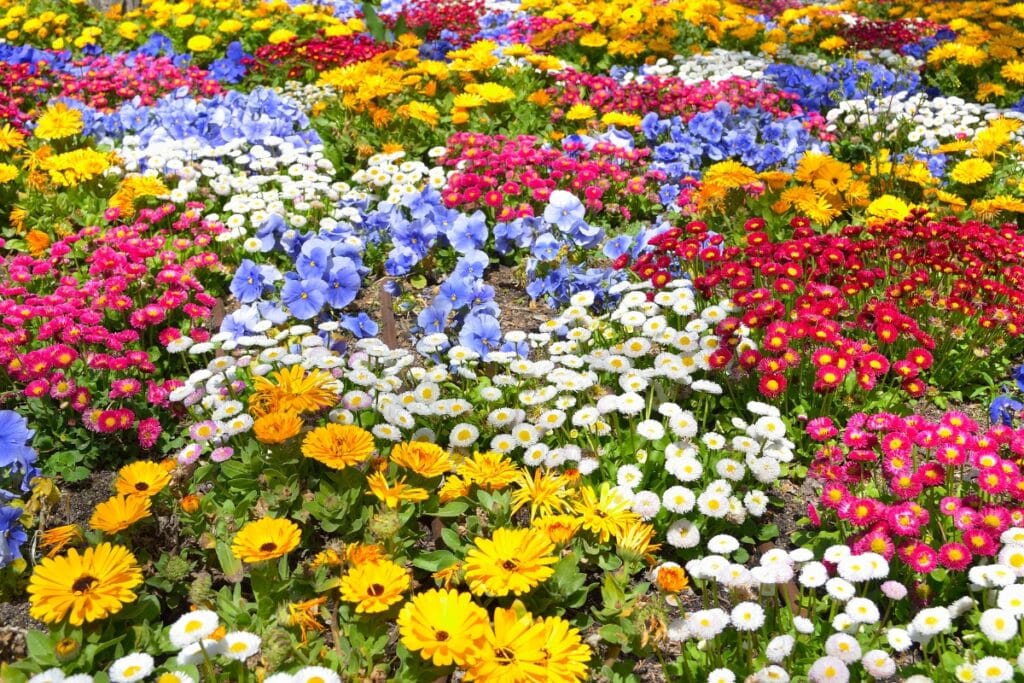
Selecting low-maintenance plants for Georgia gardens is crucial for sustainable landscaping. Native species adapted to local climate and moisture conditions thrive with minimal care, reducing pollution and aiding groundwater recharge. This section explores drought-resistant varieties, eco-friendly ground covers, and ornamental grasses that beautify yards while supporting the environment. UGA research informs these plant choices, ensuring optimal performance in Georgia‘s diverse ecosystems.
Native Plants That Thrive
Native plants that thrive in Georgia’s climate are essential for sustainable landscaping service. These resilient species, such as the Georgia aster and oakleaf hydrangea, require minimal maintenance and support local ecosystems. Landscape designers often incorporate these plants into 3D designs, creating visually appealing and environmentally friendly outdoor spaces.
When selecting native plants for hardscape projects, professionals consider factors like soil type, sun exposure, and water requirements. Proper pruning techniques help maintain the natural shape of native shrubs and trees, enhancing their beauty while preserving their low-maintenance qualities. By integrating these plants into the design, homeowners can enjoy a lush, eco-friendly yard that complements their lifestyle and supports local wildlife.
Drought-Resistant Varieties
Drought-resistant varieties play a crucial role in sustainable landscaping for Georgia gardens. Native species like the Georgia plumbago and purple coneflower thrive in low-water conditions, making them ideal choices for eco-friendly yards. A thorough site analysis helps determine optimal placement for these plants, considering factors such as lighting and soil composition.
Implementing a well-designed drip irrigationprogram can further enhance the resilience of drought-resistant plants. This efficient watering method delivers moisture directly to plant roots, reducing waterwaste and promoting deep root growth. By combining native species with smart irrigation techniques, homeowners can create beautiful, low-maintenance landscapes that withstand Georgia‘s dry spells.
Ground Covers for Eco-Friendly Yards
Ground covers play a vital role in eco-friendly yards, offering sustainable alternatives to traditional grass lawns in Atlanta. These low-growing plants improve soilhealth by preventing erosion and reducing the need for fertilizer. As temperatures rise, ground covers help maintain soilmoisture and create a cooler microclimate, benefiting both plants and wildlife.
Selecting native ground covers adapted to Georgia‘s climate ensures a green, thriving landscape with minimal maintenance. Species like creeping phlox and moss phlox not only beautify the yard but also support local ecosystems. By replacing water-hungry grass with these hardy plants, homeowners can create a more sustainablelandscape that requires less irrigation and fewer resources to maintain.
Ornamental Grasses and Their Benefits
Ornamental grasses offer numerous benefits for sustainable landscaping in Georgia, providing visual interest and ecological value. These low-maintenance plants require minimal care, making them ideal for eco-friendly yards and reducing the need for weed control. With their diverse textures and colors, ornamental grasses can enhance the aesthetic appeal of outdoor kitchens and other landscape features.
Homeowners seeking to create sustainable landscapes can incorporate native ornamental grasses to support local ecosystems and deter invasive species. These versatile plants adapt well to various soil conditions, making them suitable for different areas of the yard. For expert advice on selecting and maintaining ornamental grasses, residents can contact us to learn more about our horticulture services and sustainable landscaping solutions.
Designing Your Eco-Friendly Yard
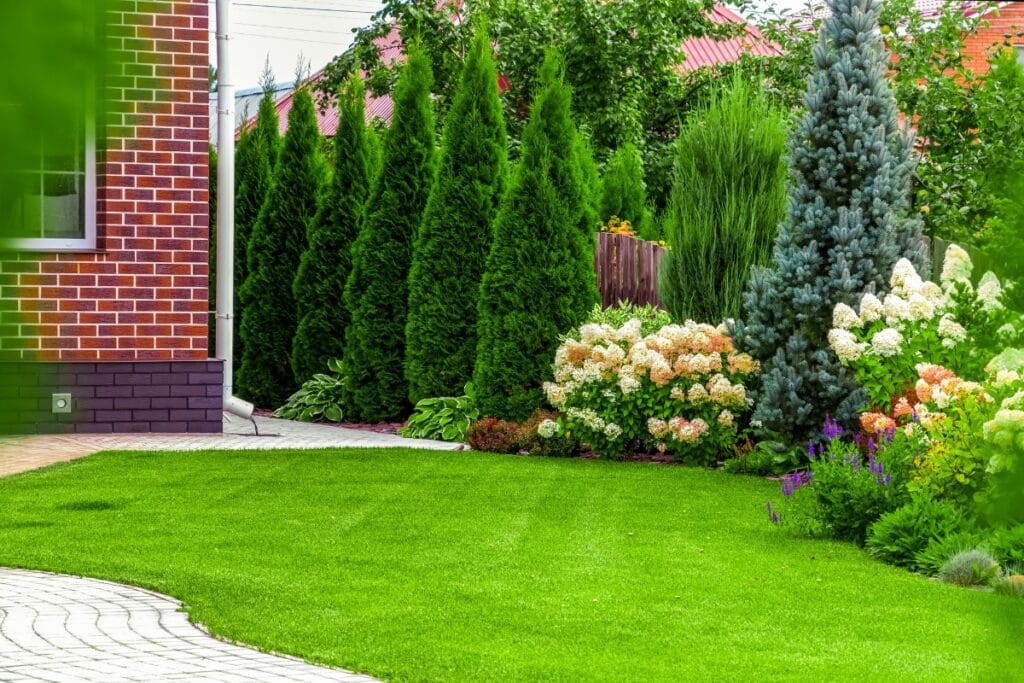
Designing an eco-friendly yard involves creating sustainable planting zones, incorporating hardscapes, and implementing water management techniques. This environmentally friendly approach focuses on efficient installation methods, including the use of native pine species. By attracting pollinators and wildlife, homeowners can enhance biodiversity while promoting groundwater conservation. These strategies work together to create a low-maintenance, sustainable landscape that thrives in Georgia’s climate.
Creating Sustainable Planting Zones
Creating sustainable planting zones is a key component of eco-friendly yard design. By grouping plants with similar water and sunlight needs, homeowners can create an efficient oasis that promotes wildlifehabitat and reduces resourceconsumption. This approach to sustainable landscaping not only benefits the planet but also minimizes maintenance requirements.
Implementing recycling practices within planting zones further enhances sustainability. Composting yard waste and using it as organicfertilizer nurtures the soil, supporting healthy plant growth without relying on chemical inputs. This closed-loop system exemplifies how thoughtful design can transform a yard into a thriving ecosystem that supports local flora and fauna while reducing environmental impact.
Incorporating Hardscapes for Low Maintenance
Incorporating hardscapes into eco-friendly yard designs reduces maintenance needs while enhancing sustainability. Permeable pavers and gravel paths allow for proper drainage, mitigating erosion issues and reducing the carbon footprint associated with traditional lawn care. These elements create defined spaces within landscapes, minimizing water-intensive grass areas and promoting efficient use of outdoor spaces.
Strategic placement of retaining walls and terraces helps manage slope challenges, preventing soilerosion and creating opportunities for diverse planting zones. By integrating these low-maintenance features, homeowners can create visually appealing landscapes that require less upkeep and support sustainable practices:
- Use permeable materials for pathways and patios
- Install retaining walls to manage slopes and prevent erosion
- Create defined outdoor living spaces to reduce lawn areas
- Incorporate rain gardens for natural water filtration
- Choose sustainable materials for hardscape elements
Water Management Techniques
Effective water management techniques are crucial for sustainable landscaping in Georgia. Homeowners can implement rainwater harvesting systems, such as rain barrels or cisterns, to capture and store water for irrigation purposes. This approach not only conserves water but also reduces carbon emissions associated with traditional water distribution methods.
The University of Georgia Extension offers valuable resources on water conservation strategies for landscaping. Homeowners can email their local extension office or follow their Instagram account for tips on efficient irrigation systems and drought-tolerant plant selection. By incorporating these water management techniques, Georgia residents can create beautiful, low-maintenance yards while supporting environmental sustainability.
Attracting Pollinators and Wildlife
Attracting pollinators and wildlife to eco-friendly yards in metro Atlanta enhances biodiversity and supports sustainable ecosystems. Incorporate native flowering plants, such as Georgia aster and butterfly weed, which provide essential nectar sources for beneficial insects and birds. Homeowners can create inviting habitats by adding water features and using mulch to retain moisture and provide shelter for various species.
Composting yard waste not only reduces landfill contributions but also produces nutrient-rich soil amendments that attract earthworms and other beneficial organisms. By strategically placing compost bins and implementing natural pest control methods, metro Atlanta residents can foster a thriving ecosystem in their yards. This approach supports local wildlife while minimizing the need for chemical interventions, aligning with sustainable landscaping principles.
Maintenance Tips for a SustainableLandscape
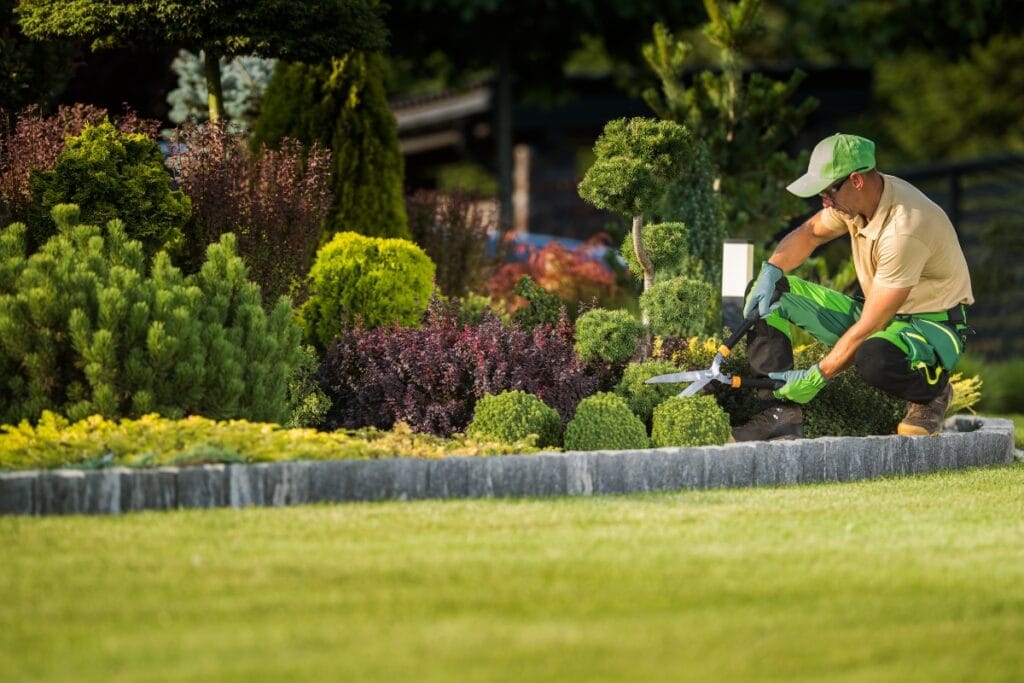
Maintaining a sustainablelandscape in Georgia requires thoughtful practices that conserve resources and support local ecosystems. This section explores efficient watering techniques, organicpest control methods, seasonal care for low-maintenance perennials like Cercis canadensis, and mulching strategies for moisture retention. These approaches minimize landscape maintenance while maximizing the benefits of sustainable gardening, ensuring a thriving, eco-friendly yard that withstands Georgia‘s variable climate.
Efficient Watering Practices
Efficient watering practices are essential for maintaining a sustainablelandscape in Georgia. Root-focused irrigation methods, such as drip systems or soaker hoses, deliver water directly to plant roots, reducing waste and promoting deeper root growth. This approach not only conserves water but also encourages plants to develop resilience against drought conditions.
Landscapedesign businesses in Georgia often recommend implementing smart irrigation controllers that adjust watering schedules based on weather conditions and soilmoisture levels. These systems ensure optimal water usage, supporting the health of low-maintenance plants while minimizing resourceconsumption. By adopting these efficient watering practices, homeowners can create thriving, eco-friendly yards that withstand Georgia‘s variable climate:
- Install drip irrigation or soaker hoses for targeted watering
- Use smart controllers to adjust watering schedules automatically
- Water deeply and infrequently to promote strong root systems
- Mulch around plants to retain soilmoisture
- Collect rainwater for irrigation during dry periods
OrganicPest Control Methods
Organicpest control methods are essential for maintaining a sustainablegarden in Georgia. Homeowners can utilize companion planting techniques, introducing beneficial insects like ladybugs and lacewings to control harmful pests naturally. This approach supports the local ecology while reducing the need for chemical interventions in lawn care.
Water features, such as small ponds or birdbaths, attract natural predators that help manage pest populations. By incorporating these elements, gardeners create a balanced ecosystem that requires fewer resources for pest management. The following table outlines effective organicpest control strategies for sustainablelandscapes:
Seasonal Care for Low-Maintenance Plants
Seasonal care for low-maintenance plants in Georgia‘s sustainablelandscapes focuses on efficient irrigation and xeriscaping techniques. Homeowners can reduce waterconsumption by adjusting irrigation schedules based on seasonal rainfall patterns and implementing rain gardens to capture and filter stormwater. These practices not only conserve water but also promote healthy plant growth throughout the year.
Incorporating native groundcoverspecies in xeriscaping designs helps minimize maintenance needs while enhancing soilhealth. As seasons change, gardeners should monitor organicmatter levels, adding compost or mulch to retain moisture and suppress weeds. By adopting these seasonal care strategies, Georgia residents can maintain thriving, eco-friendly yards with minimal effort and resource input.
Mulching for Moisture Retention
Mulching serves as a vital component in sustainable landscaping, promoting moisture retention and supporting a healthy ecosystem. By applying a layer of organic material around plants, homeowners can reduce waterevaporation, regulate soiltemperature, and suppress weed growth. This practice enhances the natural environment, allowing plants to thrive with minimal intervention and contributing to effective stormwater management.
Implementing integrated pest management strategies alongside mulching techniques further enhances the sustainability of Georgialandscapes. Organic mulches, such as pine straw or wood chips, create habitats for beneficial insects while deterring harmful pests. This approach supports biodiversity and reduces the need for chemical interventions, aligning with eco-friendly gardening practices:
Sustainable landscaping requires knowledge and resources. Georgia offers plenty for those seeking eco-friendly yard solutions.
Resources for Sustainable Landscaping in Georgia
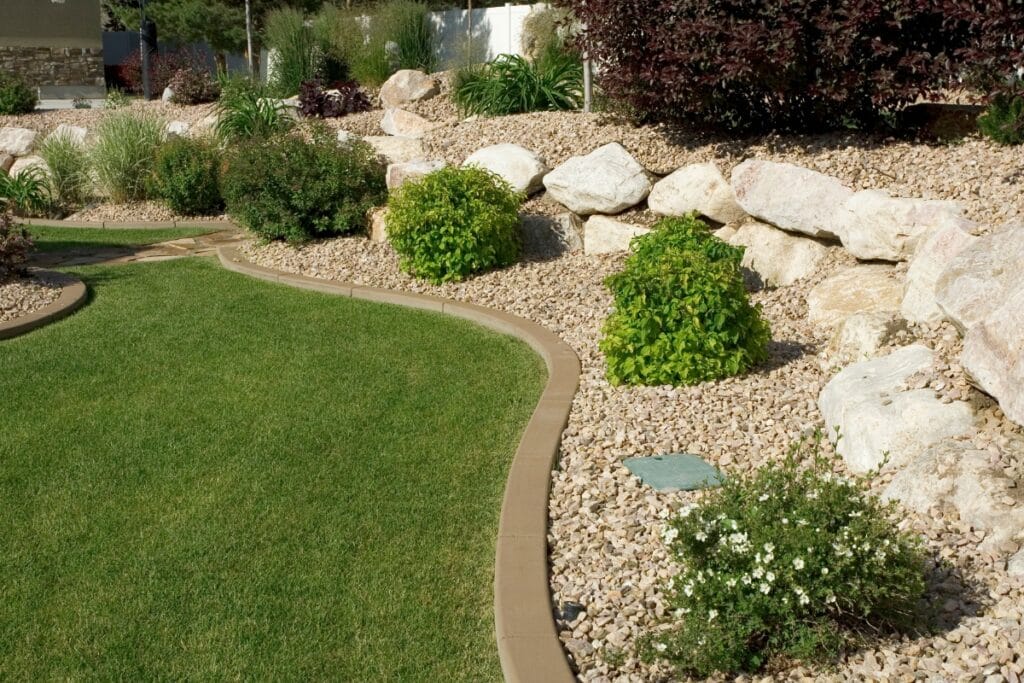
Georgia homeowners seeking sustainable landscaping solutions can access various resources to enhance their eco-friendly yards. Local gardening clubs offer expertise on native plants and water conservation. Educational workshops provide hands-on learning about pest control and tree care. Online databases help identify low-maintenance species suited to Georgia‘s climate. Connecting with eco-friendly landscaping services ensures professional guidance for implementing sustainable practices.
Local Gardening Clubs and Organizations
Local gardening clubs and organizations in Georgia provide valuable resources for homeowners seeking sustainable landscaping solutions. These groups offer expert knowledge on native plants that thrive in the local climate, reducing the need for excessive water use and air conditioning. Members share insights on creating outdoor spaces that blend seamlessly with nature, enhancing both aesthetics and environmental benefits.
Many of these organizations host workshops on eco-friendly gardening practices, teaching techniques to minimize waterpollution and maximize food production in home gardens. By participating in these community groups, residents gain access to a wealth of information on creating sustainablelandscapes that conserve resources while beautifying their outdoor spaces.
Educational Workshops and Events
Educational workshops and events offer valuable insights into sustainable landscaping practices for Georgia homeowners. These sessions cover topics such as efficient leaf management and proper mower techniques, helping participants create low-maintenance, eco-friendly yards. Attendees learn about native plant selection and insect-friendly garden designs, enhancing their understanding of local ecosystems.
Many organizations host hands-on demonstrations, allowing participants to practice sustainable techniques firsthand. These events often feature expert speakers who share their experiences in creating thriving landscapes with minimal environmental impact. By attending these workshops, homeowners gain practical skills to transform their outdoor spaces into sustainable havens that support local wildlife and conserve resources.
Online Resources and Plant Databases
Online resources and plant databases provide invaluable tools for Georgia homeowners seeking sustainable landscaping solutions. The University of Georgia Extension offers a comprehensive digital library of native plantspecies, complete with growth requirements and ecological benefits. This resource enables homeowners to select low-maintenance plants that thrive in local conditions, reducing the need for excessive watering and chemical inputs.
Several non-profit organizations dedicated to conservation in Georgia maintain interactive maps of sustainable gardens and landscapes. These virtual tours showcase successful eco-friendly designs, inspiring homeowners with practical examples of water-efficient irrigation systems and wildlife-friendly plant combinations. By leveraging these online resources, residents can visualize and plan their own sustainable outdoor spaces tailored to Georgia‘s unique climate and ecosystems.
Connect With Local Eco-Friendly Landscaping Services
Georgia homeowners seeking eco-friendly landscaping services can benefit from connecting with local experts who specialize in sustainable practices. These professionals offer valuable insights into native plant selection, water-efficient irrigation systems, and environmentally responsible maintenance techniques. By partnering with experienced landscapers, residents can create beautiful, low-maintenance yards that support local ecosystems and reduce resourceconsumption.
Experts stand out as trusted resources for sustainable landscaping in Metro Atlanta. With over 30 years of experience, their team excels in creating custom outdoor spaces that blend aesthetics with eco-friendly principles. From initial consultations to final installations, experts can guide homeowners through the process of transforming their yards into sustainable havens that enhance property value and environmental health.
Legacy’s sustainable designs took root across Georgia. Client stories blossomed, showcasing the power of eco-friendly landscapes.
Success Stories and Case Studies

Georgia‘s sustainable landscaping success stories showcase the transformative power of eco-friendly practices. This section explores real-life yard makeovers, featuring before-and-after comparisons. Interviews with local residents reveal personal experiences and insights. Lessons learned from sustainable gardening highlight practical tips for homeowners. Community initiatives demonstrate collaborative efforts in promoting environmentally responsible landscaping across the state.
Real-Life Transformations: Before and After
Experts transformed a water-intensive suburban yard into a thriving eco-friendly oasis. The team replaced thirsty turf with native grasses and drought-resistant perennials, reducing waterconsumption by 60%. Strategic placement of rain gardens and permeable pavers improved stormwater management, while native trees provided shade and habitat for local wildlife.
Another success story involved converting a barren, erosion-prone hillside into a sustainablelandscape. The design incorporated terraced gardens with native plants, stabilizing the soil and creating a visually stunning outdoor space. This transformation not only solved erosion issues but also attracted pollinators and reduced maintenance needs:
- Replaced invasive species with native plants
- Installed a drip irrigation system for efficient watering
- Created mulched pathways to reduce soil compaction
- Added a rain barrel for natural water collection
- Incorporated composting areas to improve soilhealth
Interviews With Georgia Residents
Georgia residents who have embraced sustainable landscaping practices report significant improvements in their outdoor spaces. One homeowner in Cobb County shared how replacing traditional turf with native grasses reduced waterconsumption by 40% while attracting diverse wildlife. The low-maintenance design, featuring drought-resistant perennials, allowed more time for enjoying the yard rather than maintaining it.
A North Fulton couple described their journey towards creating an eco-friendly garden, emphasizing the importance of soilhealth. By implementing composting techniques and using organicmulch, they enhanced plant growth and reduced the need for chemical fertilizers. Their success inspired neighbors to adopt similar practices, fostering a community-wide shift towards sustainable landscaping.
Lessons Learned in Sustainable Gardening
Sustainable gardening in Georgia has yielded valuable lessons for homeowners and landscapers alike. Native plant selection emerged as a critical factor in creating low-maintenance, eco-friendly yards. Gardeners found that species adapted to local conditions required less water and fewer interventions, leading to thriving landscapes that support biodiversity.
Water management techniques proved essential for sustainable gardening success. Homeowners who implemented rain gardens and efficient irrigation systems reported significant reductions in water usage and improved planthealth. These practices not only conserved resources but also enhanced the resilience of landscapes during dry periods. Key lessons learned include:
- Prioritizing soilhealth through organic amendments
- Grouping plants with similar water needs
- Utilizing mulch for moisture retention and weed suppression
- Incorporating hardscapes to reduce water-intensive areas
- Embracing integrated pest management for natural pest control
Community Initiatives in Sustainable Landscaping
Community initiatives in sustainable landscaping have gained momentum across Georgia, fostering collaboration and knowledge-sharing among residents. In Atlanta, a neighborhood group partnered with local experts to transform a neglected area into a thriving pollinatorgarden, showcasing the power of collective action in creating eco-friendly spaces. This project not only beautified the community but also served as an educational resource for sustainable gardening practices.
Rural communities in Georgia have embraced sustainable landscaping through cooperative efforts. A small town in Cherokee County initiated a rainwater harvestingprogram, installing rain barrels and constructing bioswales to manage stormwater runoff. This community-wide approach significantly reduced waterconsumption and improved local water quality, demonstrating the far-reaching benefits of sustainable landscaping initiatives:
- Established community gardens using native plants
- Organized workshops on composting and organicpest control
- Created a seed exchange program for local plant varieties
- Implemented a neighborhood-wide xeriscaping challenge
- Developed a community-led invasive species removal project
Frequently Asked Questions
What are the benefits of sustainable landscaping in Georgia?
Sustainable landscaping in Georgia conserves water, reduces maintenance costs, and supports native wildlife. It promotes soilhealth, minimizes chemical use, and enhances property value. By utilizing native plants and efficient irrigation, homeowners can create beautiful, eco-friendly outdoor spaces that thrive in Georgia‘s climate.
Which native plants are best for low-maintenance gardens in Georgia?
Native plants ideal for low-maintenance gardens in Georgia include oakleaf hydrangea, butterfly weed, black-eyed Susan, coneflower, and dwarf yaupon holly. These species thrive in the state’s climate, require minimal care, and provide year-round interest while supporting local wildlife.
How can I design an eco-friendly yard for my Georgia home?
To create an eco-friendly Georgia yard, focus on native plants that thrive in the local climate and support wildlife. Incorporate rainwater harvesting systems, use organicmulch, and minimize lawn areas. Consider permeable paving options and install energy-efficient outdoor lighting to reduce environmental impact while enhancing your home’s beauty.
What are essential maintenance tips for a sustainablelandscape in Georgia?
Sustainablelandscapes in Georgia thrive with proper watering, mulching, and native plant selection. Regular pruning, pest monitoring, and soil testing help maintain health. Composting and rainwater harvesting contribute to eco-friendly practices. Seasonal adjustments and minimal chemical use further enhance sustainability.
Where can I find resources for sustainable landscaping projects in Georgia?
Legacy LandscapeDesign offers sustainable landscaping resources in Georgia. Their experts can provide eco-friendly solutions for outdoor projects, including pools, decks, and patios. Serving Cobb County, North Fulton, and parts of Cherokee, Paulding, and Bartow counties, Legacy’s team focuses on creating custom plans that exceed client expectations while prioritizing environmental responsibility.
Native Plants, Stunning Results: Start Your Project Today With Legacy Landscape Design
Transforming your Georgia landscape into an eco-friendly oasis is easier than you think—when you choose the right low-maintenance, drought-tolerant plants. At Legacy Landscape Design, we specialize in sustainable landscaping solutions that enhance your home’s beauty while conserving water and supporting local ecosystems.
Whether you’re dreaming of native pollinator gardens, xeriscaped pathways, or lush perennial borders, our team will design a yard that thrives with minimal effort. Ready to reimagine your outdoor space? Call us today at 770-427-2026 or fill out our online contact form to schedule a consultation. Let’s build a landscape legacy together—one that’s as kind to the environment as it is breathtaking.



